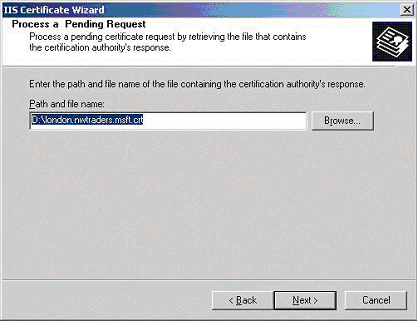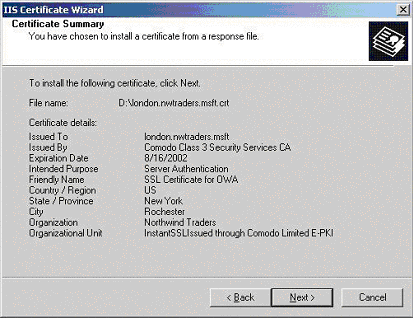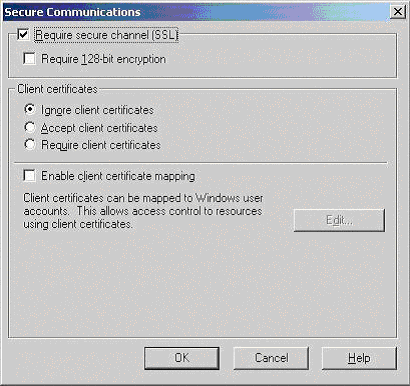 |
Support
Securing Your Outlook Web Access 2000 Implementation Using SSL
Certificate Installation
- Open Internet Services Manager from your Administrative Tools.
- Open the Properties for the Web Site that is hosting OWA (normally the Default Web Site).
- Select the "Directory Security" tab and then click on the "Server Certificates" button.
- You will now be presented with the "Pending Certificate Request" dialogue box (below), select "Process the pending request and install the certificate", click Next.

- The "Process a Pending Request" dialogue box will appear (below), navigate to the site certificate that you received. click Next.

- You will now be presented with the "Certificate Summary" (below), click Next.

- Next you will need to install the intermediate certificate, please follow the instructions at:
http://www.InstantSSL.com/ssl-certificate-support/cert_installation/iis_ssl_certificate_5x.html
You have now installed the SSL certificate into our web site, the next step is to enable SSL for OWA - this is a pretty simple task.
- Using the Internet Services Manager, open the properties for the "Exchange" virtual directory.

- Select the "Directory Security" tab and the click on the "Edit" button in the Secure Communication section.
- In the "Secure Communications" dialogue box (below), check the box "Require Secure Channel (SSL)", you could also check the box "Require 128-bit encryption", if you do check the 128-bit checkbox, any browsers that do not support 128-bit encryption will be unable to connect to OWA.

When users enter http://ahost.adomain.com/exchange, they will receive an "HTTP 403.4 - Forbidden: SSL required Internet Information Services" error message, because OWA is configured to require SSL. SSL uses the HTTPS protocol, so users would need to enter the url as https://ahost.adomain.com/exchange.
Please see the Microsoft article regarding forcing the use of SSL with OWA:
http://support.microsoft.com/default.aspx?scid=kb;en-us;234022
One final step that you may need to take is to ensure that your Firewall is configured to allow HTTPS (port 443 by default) to pass through.
|
|